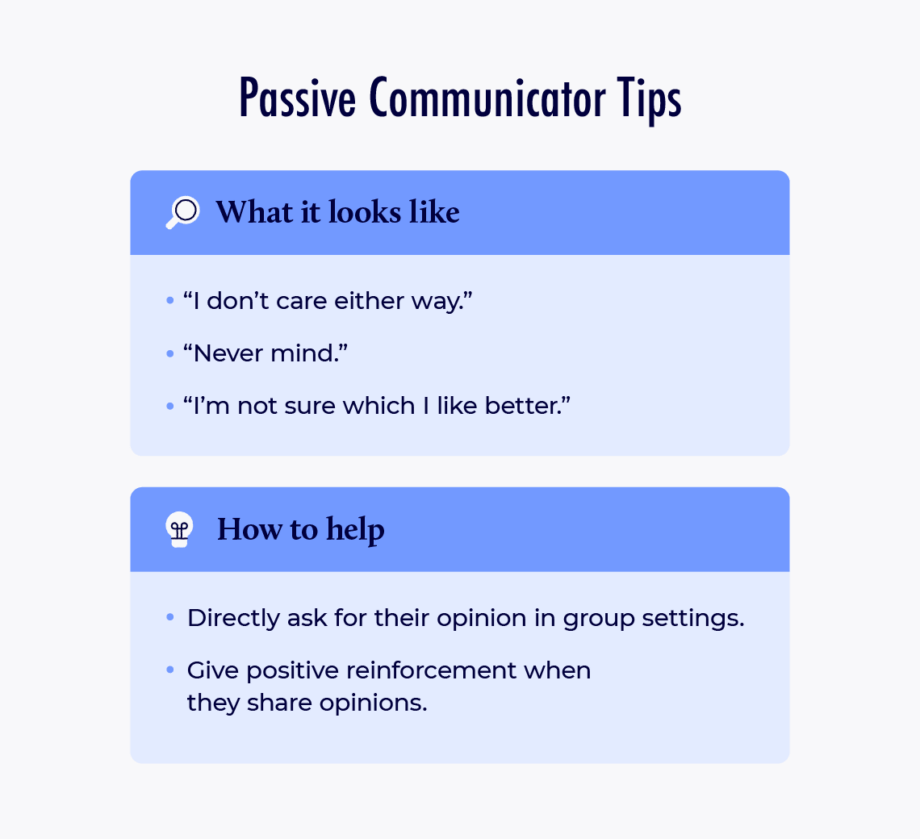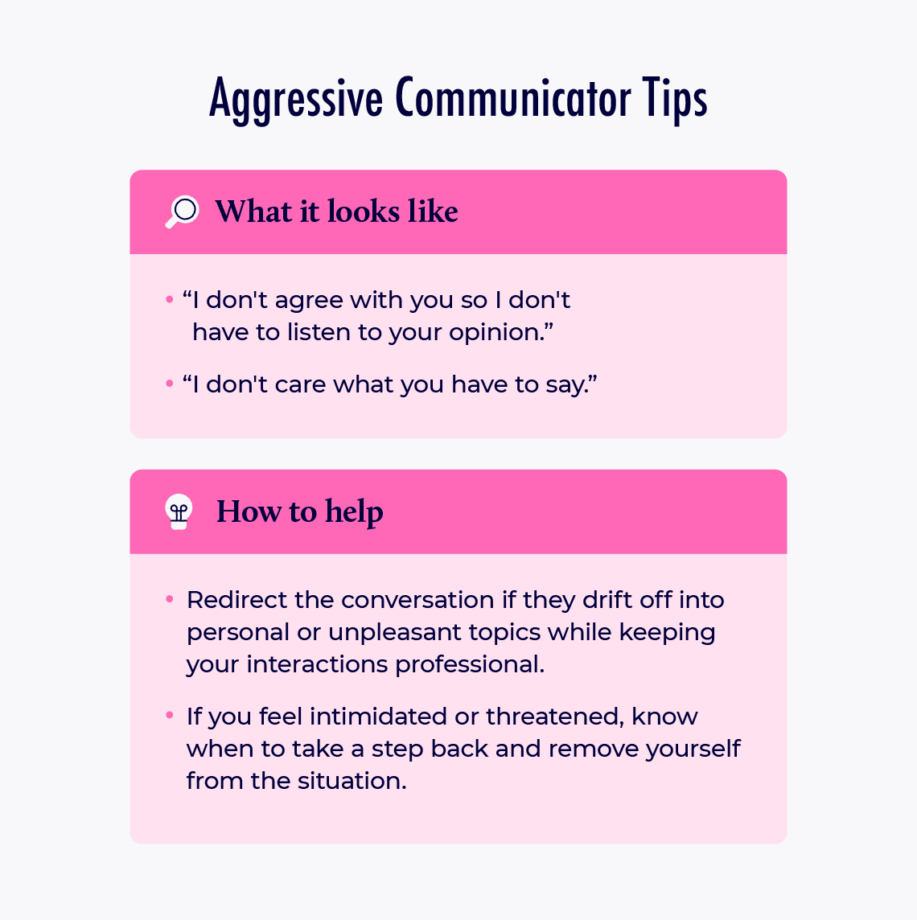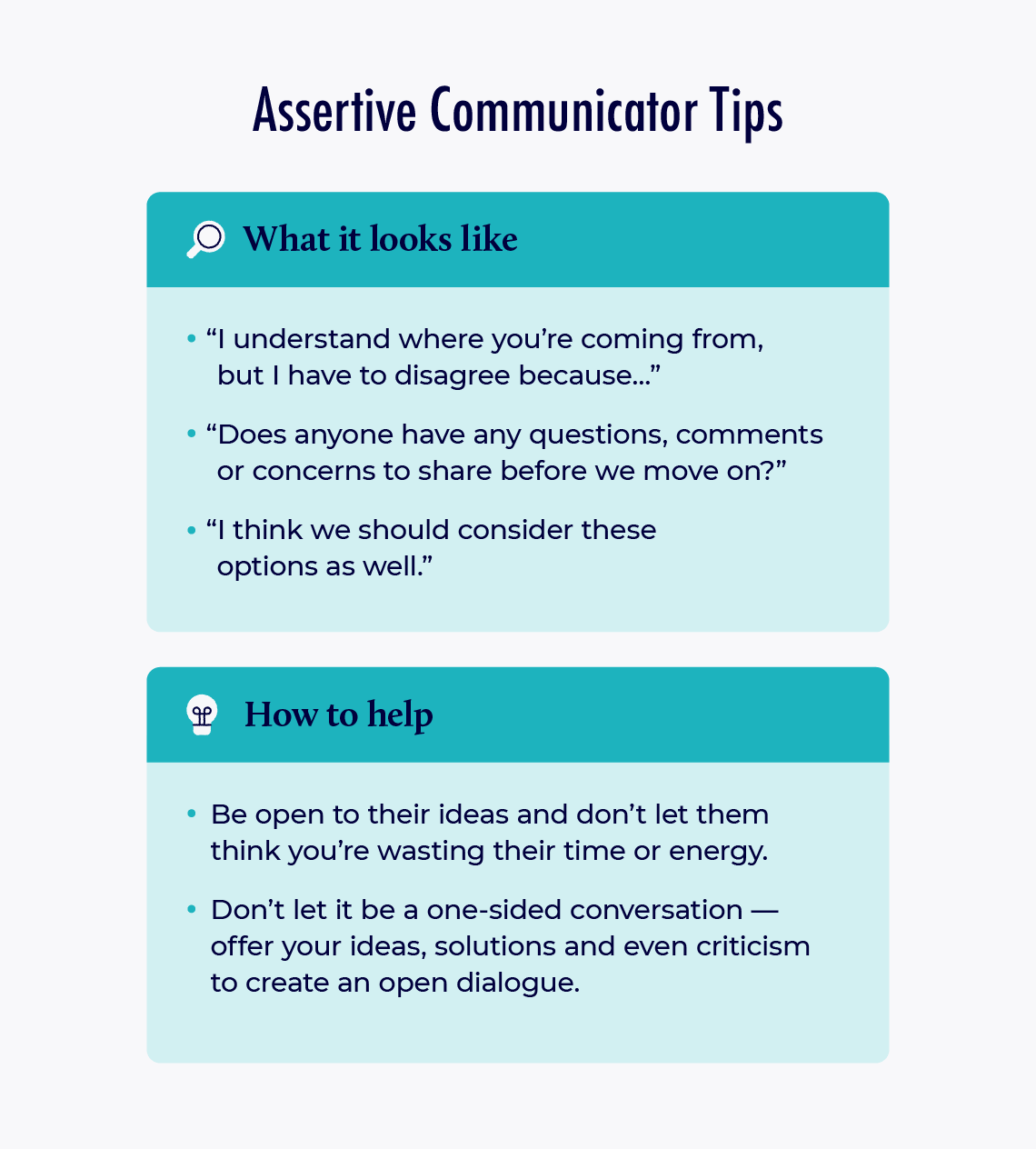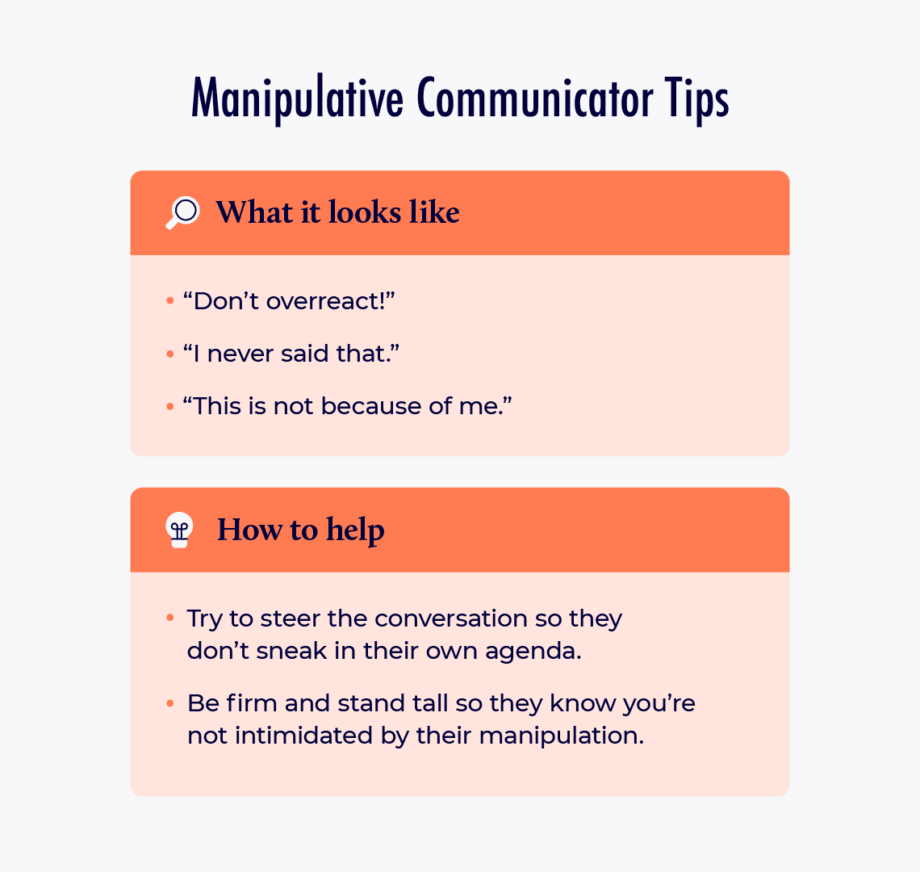Communication is hard.
Why? Because everyone has a unique style of communication.
And communicating effectively with one team member might look significantly different than with another.
Learning the different examples of communication styles in the workplace makes you more likely to collaborate effectively and earn recognition for your work.
In this guide, I’ll go through the five communication styles in the workplace, how to work with each style and share actionable tactics to improve your communication at work.
Key Takeaways
- The five communication styles in the workplace are passive, aggressive, passive-aggressive, assertive and manipulative.
- Each type of communication has its strengths and weaknesses.
- Improving your communication strengthens relationships inside and outside the workplace.

1. Passive Communication
Passive communicators often have difficulty expressing feelings or needs, especially in the workplace. Many describe passive communicators as people pleasers.
These people often defer to others when making decisions to avoid conflict or tension. This is also described as a submissive communication style.
It’s also common for passive communicators to act indifferent and reject taking a stance, which can result in misunderstandings or resentment.

How to Work with a Passive Communicator
Working with passive communicators can be tough because they’re less likely to communicate what they think or feel.
But that doesn’t mean they don’t have anything to say.
Passive communicators are more likely to take the path of least resistance instead of choosing sides since they believe their ideas are often overlooked and underappreciated.
To work with a passive communicator, you need to spend more time coaxing out their thoughts or provide low-stakes situations for them to freely share their opinion.
Example of a passive communicator:
- “I don’t care either way.”
- “Never mind.”
- “I’m not sure which I like better.”
There are several ways to work effectively with passive communicators:
- Be direct: Ask passive communicators their opinions directly while creating enough space for them to share their views. Actively listen to their responses and acknowledge their contributions.
- Don’t be dismissive: Understand that passive communicators aren’t confident sharing their ideas, so instead of shutting them down, highlight their value.
- Keep things light and positive: Avoid being confrontational or angry when communicating with them so they don’t shut down.
2. Aggressive Communication
Aggressive communicators have no trouble expressing their thoughts and feelings. This type of communication in the workplace can sometimes be perceived as hostile or defensive.
People who fall under this category tend to have more dominant mannerisms, such as speaking loudly, maintaining intense eye contact or stepping into the personal space of others while talking.
They have little fear of speaking up in meetings and may actually end up steamrolling other team members who are less confident in their contributions.
Sometimes, aggressive communicators have trouble conveying their message due to their tone.
The issue with aggressive communication isn’t so much what the person is saying, but rather the harsh delivery of the message.

How to Work With an Aggressive Communicator
When it comes to interacting with an aggressive communicator in the workplace, misinterpretation and fear are common.
These people often speak louder than their peers while maintaining strong eye contact, sometimes even overstepping into others’ personal space.
Example of aggressive communication:
- “I don’t agree with you so I don’t have to listen to your opinion.”
- “I don’t care what you have to say.”
- “I’ll do it my way because I think you’re wrong.”
Here are a few things to consider when working with an aggressive communicator:
- Stay cool, calm and collected: Try to not let the aggressive communicator intimidate you when conversing with them.
- Keep things professional: Redirect the conversation if it drifts off into personal or unpleasant topics.
- Walk it off: If you feel intimidated or threatened, know when to take a step back and remove yourself from the situation.
3. Passive-Aggressive Communication
Passive-aggressive is a type of communication that combines two styles.
While you may think combining two communication styles is the best of both worlds, it can actually be more frustrating and confusing.
On the surface, passive-aggressive communicators appear easygoing or nonchalant, but their actions lean more aggressively.
In other words, their actions and words don’t always align.
People who identify with this style of communication act out because they feel manipulated or powerless.
You may notice sarcasm, resentment or gossip coming from a passive-aggressive communicator.

How to Work With a Passive-Aggressive Communicator
Working with a passive-aggressive communicator can be tough because you have to navigate the passiveness on the surface and the aggression that simmers underneath.
This communication style in the workplace can be very toxic and divisive, and it will damage relationships and morale if left uncorrected.
Example of passive-aggressive communication:
- “OK, let’s do it your way…but it’s not going to work.”
- “I’m not mad, but it’s whatever. You didn’t listen to me.”
- “That presentation was…interesting. Very different from your usual style.”
While it’s not easy to work with someone who identifies as passive-aggressive, I have a few tips to help you out:
- Foster a culture of transparency: Provide space for employees to share their honest opinions to prevent them from building up private feelings of dissent. Implementing 360-degree feedback tools is a great way to do this.
- Be understanding: Try to understand their motives and reasons why they may be acting this way, and then try to help them solve the issue.
- Switch up the communication style: Don’t respond in the same way unless you want the cycle to continue — focus on being assertive instead.
- Take a stand: Demonstrate other communication styles in the workplace to show employees how you prefer others to deliver their messages.
4. Assertive Communication
The assertive communication style is all about being respectful and confident. Known for its effectiveness in the workplace, this style is an example of clear and direct communication while valuing the opinions of others.
People who embody this type of communication are self-aware in conversations and are careful not to steamroll their peers.
You won’t find an assertive communicator manipulating others, but you will notice they express their opinions clearly. You might also notice that assertive communicators have high self-esteem organically vs. being aggressive.
However, it’s not uncommon for assertive communicators to be misinterpreted as aggressive.

How to Work With an Assertive Communicator
Assertive communication in the workplace is ideal because it promotes and encourages collaboration and demonstrates leadership.
You don’t need to be afraid to express yourself in front of an assertive communicator because they will listen to your thoughts and feelings without judgment.
They may even make you feel more comfortable in certain situations.
If you’re ever unsure about something, you can always turn to an assertive communicator because they will listen to understand rather than respond.
Example of assertive communication:
- “I understand where you’re coming from, but I have to disagree because…”
- “Does anyone have any questions, comments or concerns to share before we move on?”
- “I think we should consider these options as well.”
Here are a few things to consider when working with an assertive communicator:
- Give them time: Allow enough room for these folks to share their ideas and solutions without interrupting.
- Don’t be dismissive: Be open to their ideas and don’t let them think you’re wasting their time or energy.
- Keep things conversational: Prevent one-sided conversations — offer your ideas, solutions and even criticism to create an open dialogue.
5. Manipulative Communication
Manipulative communicators are exactly what they sound like.
They use deceit or flattery to influence and control the actions and conversations of their peers.
People who fall under this style of communication in the workplace know what they want and won’t stop until they get it. They are known for being insincere and condescending.
It’s hard to understand the true intentions of someone who resorts to manipulative communication.

How to Work With a Manipulative Communicator
It’s difficult to work with a manipulative communicator because they don’t say exactly what they mean.
These people would rather bury their true intentions underneath a facade to get their way.
People will not respond well once they realize they’ve been manipulated by one of their co-workers.
If you confront a manipulative communicator, they may respond with criticism or harsh comments to ensure they are still in control of the situation.
Example of manipulative communication:
- “Don’t overreact!”
- “I never said that.”
- “This is not because of me.”
Consider these tips when working with a manipulative communicator:
- Redirect the communication style: Try to steer the conversation so they don’t sneak in their own agenda.
- Don’t use criticism: Show the person how you wish they would respond to the situation and be assertive.
- Stay calm: Be firm and stand tall so they know you’re not intimidated by their manipulation.
Working with a manipulative communicator is an unsavory position for anyone to be in. Learning how to work with them — and shield your team from them — effectively and compassionately is important to grow your leadership skills.
How To Improve Your Communication Style in the Workplace
No one is perfect — it takes time, patience and practice to master your communication style and develop effective collaboration within your team.
Note that these examples of communication styles aren’t rigid categories. You can seamlessly blend elements from different styles to tailor your message and create a strong management style.
Here’s how you can fine-tune your communication style in the workplace, just like great leaders do.
Talk With People, Not at Them
Communication isn’t a one-way street.
The first step to fine-tuning your communication style is becoming aware of your own tendencies.
Instead of lecturing and talking at people, engage with your peers’ talking points.
Make sure to give your co-workers space to share their thoughts and feelings, especially when it’s their turn to speak. Listen to understand, not to respond.
For a passive communicator, this might look like reading body language and asking that team member directly if they have something to contribute. For aggressive communicators, you’ll need to make sure they feel respected and heard — building off their ideas rather than changing or rejecting them.
Adapting your communication style to resonate with different personalities fosters a sense of respect and psychological safety, which are key factors in retaining top employees.
Be Authentic
Expressing care and empathy can go a long way in the workplace.
These characteristics play a huge role in developing organic relationships and effective communication habits.
It’s important to stick to your normal communication style while finding a middle ground with your peers who may have a different style.
Accept (and Encourage) Feedback
One way you can improve your communication style in the workplace is by being open to feedback.
Accepting feedback is also an effective way to recognize employees in the workplace.
Providing and encouraging feedback among your teammates can improve relationships and foster healthy collaboration.
Try utilizing the 360-degree feedback method of gaining responses from all co-workers.
Embrace Your Differences and Ask Questions
All team members should add something to the company’s culture rather than blending in.
Embrace the differences.
Don’t shut down any opinions or ideas — instead, ask questions to better understand where the person is coming from. Then, use that information to grow in the way you communicate with others.
Improving Communication One Day at a Time
Communication plays a major role in the success of your business or the trajectory of your career.
And it’s not a one-off project. It’s a process that is always being refined.
You’ll never master it, but you can always be in pursuit of mastering your communication style. I guarantee you’ll be rewarded when you do.
To improving your communication,
Thomas







Leave a Reply